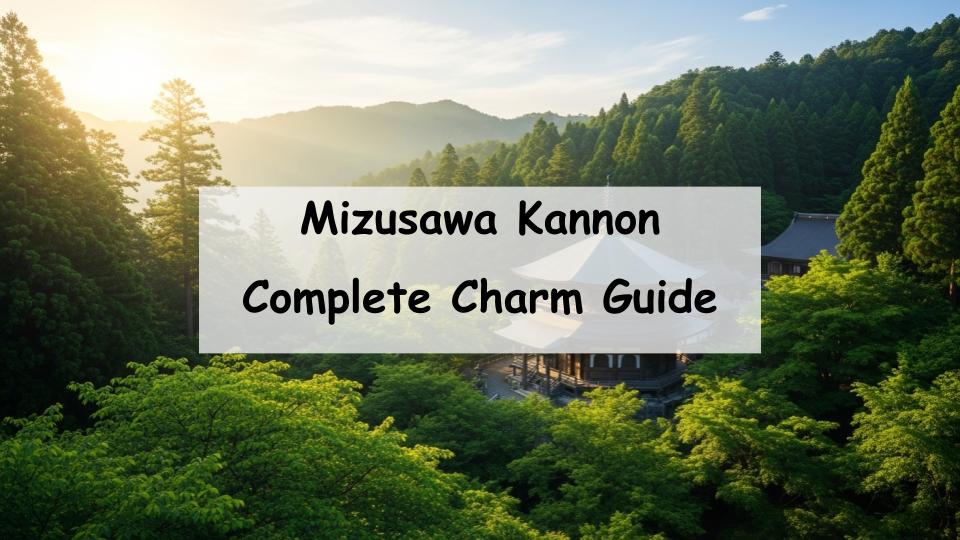“What kind of temple is Mizusawa Kannon?” “What blessings can I receive there?” “Is it easy to include in my sightseeing itinerary?” Many people might have these questions.
To answer simply, Gotokuzan Mizusawa-dera, commonly known as Mizusawa Kannon, is a historic temple located in the Ikaho area of Gunma Prefecture. It is a popular spot with unique attractions like the Hexagonal Hall and the Yakuyoke (warding off evil) Kannon statue. It is especially known for blessings related to conception, safe childbirth, and protection from misfortune, attracting many worshippers.
In this article, we will clearly explain Mizusawa Kannon’s history, sect, and basic information, along with highlights within the temple grounds, annual events, access details, and nearby sightseeing spots. Even first-time visitors can enjoy a worry-free visit. Please read on till the end.
- What is Gotokuzan Mizusawa-dera (Mizusawa Kannon)? History and Basic Information
- Detailed Highlights of Mizusawa Kannon
- Cultural Assets and Historical Value of Gotokuzan Mizusawa-dera
- Annual Events and Seasonal Attractions
- Access to Mizusawa Kannon and Nearby Sightseeing
- Practical Information Before Your Visit
What is Gotokuzan Mizusawa-dera (Mizusawa Kannon)? History and Basic Information
The Founding and Origin of Mizusawa Kannon
Gotokuzan Mizusawa-dera has a history spanning over 1,300 years and is deeply rooted in the Ikaho region of Gunma Prefecture. While some details of its founding remain unclear, it has been cherished by local people for centuries.
Religious Sect and Features of the Principal Image
The temple belongs to the Tendai sect of Buddhism. Its principal image is the Eleven-faced Thousand-armed Kannon, also known as the Yakuyoke Kannon for warding off evil and misfortune. The compassionate expression of the Kannon statue brings peace of mind to visitors.
The Meaning Behind the Names “Mizusawa-dera” and “Mizusawa Kannon”
The name “Mizusawa-dera” comes from the local area where the temple is located. “Mizusawa Kannon” refers to the Kannon deity enshrined here, symbolizing the faith of the local community. Both names are widely used and beloved.
Detailed Highlights of Mizusawa Kannon
The Hexagonal Hall: Structure and How to Spin It
One of the temple’s main attractions is the Hexagonal Hall, which houses sacred scriptures. Visitors believe that spinning this hall clockwise brings blessings such as fulfillment of wishes and protection from misfortune. Many take their time spinning it while praying.
The Harmony of the Temple’s Architecture and Nature
The temple grounds feature traditional wooden buildings, including the main hall, beautifully blending with the lush natural surroundings. Cherry blossoms in spring and colorful autumn leaves add seasonal charm that captivates visitors year-round.
Blessings and Popular Worship Spots
Mizusawa Kannon is especially revered for blessings related to conception, safe childbirth, and warding off evil. Many families and expectant mothers come to pray here.
Stories of Blessings for Conception, Childbirth, and Protection from Misfortune
There are many testimonies from worshippers who experienced successful conception or safe childbirth after praying here. Such stories have helped maintain strong faith and attract visitors nationwide.
Cultural Assets and Historical Value of Gotokuzan Mizusawa-dera
Statues and Treasures Preserved at the Temple
The temple preserves many historically valuable Buddhist statues and treasures, which are cherished cultural assets that tell the story of the region’s heritage.
Historic Buildings and Their Cultural Property Status
Buildings such as the main hall and Hexagonal Hall maintain traditional architectural styles and some are designated as important cultural properties by the Japanese government, highlighting their historical significance.
Deep Local Faith and Traditions
Mizusawa-dera is closely connected with local community life, participating in festivals and traditional events. The strong bond between the temple and the region continues to this day.
Annual Events and Seasonal Attractions
Major Events like New Year’s Visits and Setsubun Festival
The temple is bustling during events such as the New Year’s visit and the Setsubun festival, which involves rituals for warding off evil. The bean-throwing ceremony during Setsubun is a cherished local tradition.
Seasonal Scenery and Atmosphere
Visitors can enjoy the temple throughout the year with stunning cherry blossoms in spring, vibrant autumn foliage, and serene snowy landscapes in winter. Each season offers a unique experience.
Special Prayers and Limited-Time Exhibitions
Occasionally, special prayers and exhibitions of hidden statues are held, providing unique spiritual and cultural experiences. It is advisable to check these events in advance.
Access to Mizusawa Kannon and Nearby Sightseeing
How to Get There by Train and Bus
The nearest train station is JR Shibukawa Station. From there, a bus ride of about 20 minutes will bring you to the temple. It’s recommended to check bus schedules ahead of time.
Directions by Car and Parking Information
By car, Mizusawa Kannon is approximately 15 minutes from the Shibukawa-Ikaho Interchange on the Kan-Etsu Expressway. There is a free parking lot near the temple, making access convenient.
Nearby Attractions: Ikaho Onsen and Haruna Shrine
When visiting Mizusawa Kannon, it is recommended to also explore nearby spots like Ikaho Onsen and Haruna Shrine. Combining these destinations makes for a fulfilling travel plan.
Practical Information Before Your Visit
Opening Hours, Admission Fees, and Holidays
The temple is generally open from 8:00 a.m. to 5:00 p.m. Admission is free or donation-based. There are no regular holidays, but special events may affect opening times.
Etiquette and Important Notes Within the Temple Grounds
Visitors should maintain a quiet and respectful demeanor when praying. Eating, drinking, and smoking are prohibited in many areas, so it’s important to follow the temple’s rules.
Photography Rules and Recommended Spots
Photography is generally allowed in most areas except during prayers or near the principal image. Popular spots for photos include the Hexagonal Hall and the surrounding natural scenery.





Comment